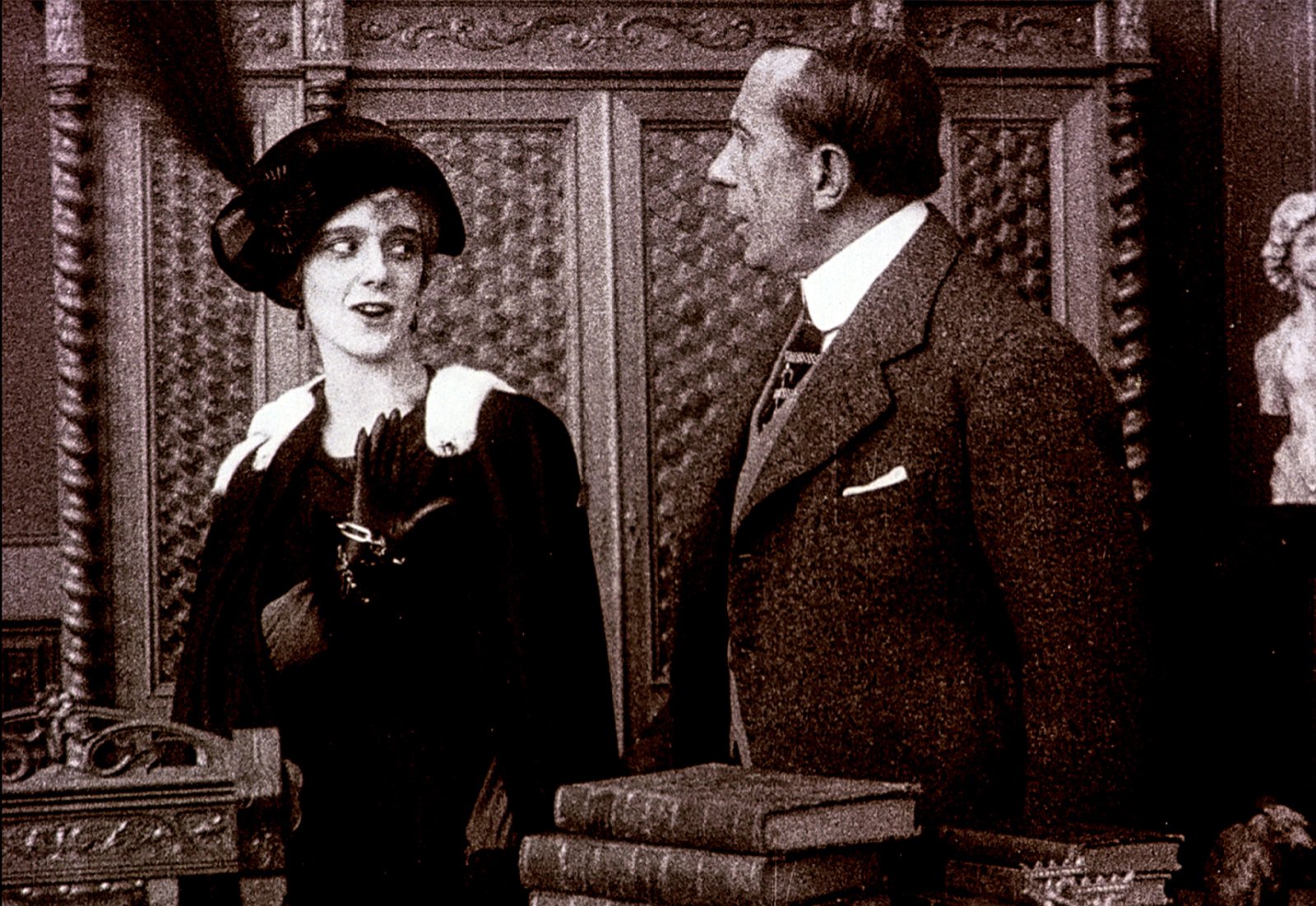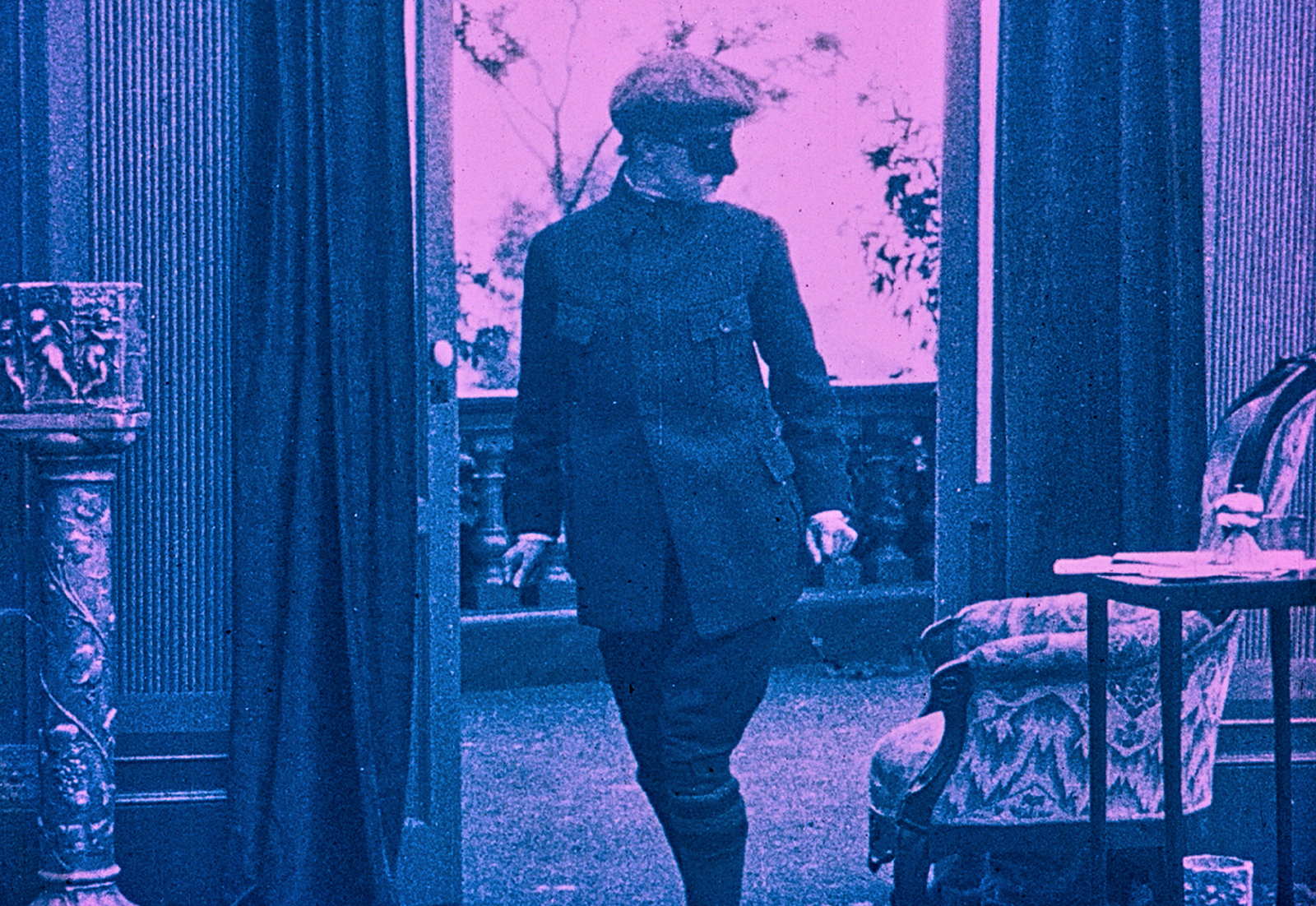FILIBUS




6:00PM, Sunday October 17
Classic Cinemas, Elsternwick
Introduced by Geoff Gardner
Director: Mario Roncoroni
Country: Italy
Year: 1915
Runtime: 76 minutes
Language: English intertitles
Format: B&W with colour tinting & toning, 2K DCP (originally 35mm)
Rating: Unclassified 15+
Classic Cinemas, Elsternwick
Introduced by Geoff Gardner
Director: Mario Roncoroni
Country: Italy
Year: 1915
Runtime: 76 minutes
Language: English intertitles
Format: B&W with colour tinting & toning, 2K DCP (originally 35mm)
Rating: Unclassified 15+
Tickets⟶
“Anticipating the
kind of anxieties that were recently raised by Joker, [scriptwriter] Bertinetti
argued that seemingly ‘frivolous’ movies were a form of ‘light hypnosis’ useful
in stimulating passive spectators to action — and thus raising the possibility
that Filibus was intended to inspire
a nation of independent women if not crossdressing burglars.”
— J. Hoberman, The New York Times.
CINEMA REBORN’S FIRST EVER SILENT CLASSIC
“No other crime thriller compares to Filibus!” exclaimed a Corona Films ad in the April 1915 edition of the Italian film magazine La Vita Cinematografica — and for once the ballyhoo was correct! Directed by Mario Roncoroni and scripted by future science fiction author Giovanni Bertinetti, Filibus is the most exciting, witty, feminist, steampunk, cross-dressing aviatrix thriller you will ever see!
Filibus was recently remastered by Amsterdam's Eye Filmmuseum, restoring the film’s marvellous range of Desmet tinting and toning in the original nitrate material. To bring the film back to its flavour of the period, US distributor Milestone hired young poet Austin Renna to write new intertitles based on an improved translation by Eye’s archivist Elif Rongen-Kaynakçi. A new stunning orchestral score acompanies this fantastic film.

Presented in a 2K Restoration by Amsterdam’s Eye Filmmuseum.
— J. Hoberman, The New York Times.
CINEMA REBORN’S FIRST EVER SILENT CLASSIC
“No other crime thriller compares to Filibus!” exclaimed a Corona Films ad in the April 1915 edition of the Italian film magazine La Vita Cinematografica — and for once the ballyhoo was correct! Directed by Mario Roncoroni and scripted by future science fiction author Giovanni Bertinetti, Filibus is the most exciting, witty, feminist, steampunk, cross-dressing aviatrix thriller you will ever see!
Filibus was recently remastered by Amsterdam's Eye Filmmuseum, restoring the film’s marvellous range of Desmet tinting and toning in the original nitrate material. To bring the film back to its flavour of the period, US distributor Milestone hired young poet Austin Renna to write new intertitles based on an improved translation by Eye’s archivist Elif Rongen-Kaynakçi. A new stunning orchestral score acompanies this fantastic film.
Presented in a 2K Restoration by Amsterdam’s Eye Filmmuseum.
Film Notes by Susan Potter:
Mario Roncoroni
Mario Roncoroni directed over twenty films in Italy and
Spain between 1915 and 1928, specialising in adventure serials and melodramas.
What little is known of his career suggests that his opportunities to direct
were likely affected by war and social unrest: World War I and its disastrous
impact on the Italian film industry, and then the turbulent politics of Spanish
society preceding the Civil War of the 1930s.
Born in 1881 in the north-eastern region of multi-ethnic Istria when it was still part of the Austro-Hungarian Empire, Roncoroni started out as a stage actor, a career choice perhaps unsurprising since he was the son of an actor. His first credit for a film role appears in 1912, and two years later he signed a contract to work for a new low-budget production company based in Turin, Corona Film. Filibus may be his directing debut, prior to two other titles he directed for the company in 1915 which were released towards the end of that year. Filibus is a delightful archival discovery and as an artefact of international popular culture it is just as important as Roncoroni’s other notable feature film, La nave (The Ship) (Ambrosio Film, 1921), co-directed with Gabriellino D’Annunzio, son of the decadentismo poet Gabriele D’Annunzio, and starring celebrity Russian dancer Ida Rubenstein. Roncoroni’s move to Valencia in the 1920s to seek directing work seems ultimately to have diminished his artistic connections and also interfered with any long-term directing ambitions. After a false start, he directed several feature films in the late 1920s, but subsequently his name disappears from the historical records, apart from a brief notice in a 1931 newspaper offering his teaching services to aspiring actors.
Born in 1881 in the north-eastern region of multi-ethnic Istria when it was still part of the Austro-Hungarian Empire, Roncoroni started out as a stage actor, a career choice perhaps unsurprising since he was the son of an actor. His first credit for a film role appears in 1912, and two years later he signed a contract to work for a new low-budget production company based in Turin, Corona Film. Filibus may be his directing debut, prior to two other titles he directed for the company in 1915 which were released towards the end of that year. Filibus is a delightful archival discovery and as an artefact of international popular culture it is just as important as Roncoroni’s other notable feature film, La nave (The Ship) (Ambrosio Film, 1921), co-directed with Gabriellino D’Annunzio, son of the decadentismo poet Gabriele D’Annunzio, and starring celebrity Russian dancer Ida Rubenstein. Roncoroni’s move to Valencia in the 1920s to seek directing work seems ultimately to have diminished his artistic connections and also interfered with any long-term directing ambitions. After a false start, he directed several feature films in the late 1920s, but subsequently his name disappears from the historical records, apart from a brief notice in a 1931 newspaper offering his teaching services to aspiring actors.
The Film
Filibus is an exhilarating crime caper starring
Valeria Creti as the film’s eponymous anti-heroine who steals for the thrill of
it while planning an intricate trap for the detective pursuing her. It won’t be
giving anything away to say that the opening sequence sets up the film’s
central conceit. Filibus, in one of her disguises as the elegant fox-stole-cladded
Baroness Troixmond, reads in the newspaper that a reward is being offered for
any information leading to her arrest. In a daring move, she visits the
magistrate in charge of the search claiming, in suitably self-deprecating and
feminine style, that she is a bit of an amateur detective and she’d like to
enter the competition for the reward. Most boldly, when Detective Kutt-Hendy (Giovanni
Spano) arrives at the magistrate’s office, she states directly that he is
Filibus and she will prove it—after her departure from the scene, both men
laugh knowingly together, but by the end of the film it is Filibus who has the
last laugh.
The opening prologue, where the actors are presented to the audience, has already put on display all three of Filibus’s disguises—masked thief in masculine cap and jacket dissolves to the worldly Baroness Troixmond, and then the dapper, moustachioed Count de la Brive with his homburg and little monocle. But the finely-tuned plot manoeuvres that Filibus instigates bring into being a fourth possibility, and perhaps her most audacious, that of the detective on her trail. The Egyptian statue plotline is a showy tease, a merciless display of ingenuity and entrapment, and a kind of reverse gaslighting—given its typical gender co-ordinates—of the detective and his forensic calculations. This might be the most feminist plot twist of the film, to suggest that Filibus is able to manipulate and control—to the point of almost assuming his identity—the film’s most patrician and authoritative character.
Watching Filibus now, being immersed in its astonishingly vibrant colours, can feel like viewing a cinematic singularity. But it is not a one-off. It is one surviving example of a group of internationally popular genres of the 1910s, from the American ‘serial-queen’ action melodramas with their astounding stunts, to elaborately plotted crime thrillers, most notably Louis Feuillade’s sensational Fantômas series. This was the decade when cinema became a global mass medium watched by millions, when Charlie Chaplin became a star. There has been a tendency to read Filibus as less than original—even on its 1915 release reviewers noted its debts to Feuillade in terms of cinematography and plot elements—but this was a period in which imitation as adaptation was usual and well-practiced. Filibus is a far cry from the perversions of sex and religion visited upon us in Fantômas, exemplified by the famous scene in Le faux magistrat where blood and pearls rain down on a group of mourners, spilling from the pockets of a dead gangster tied to the clapper of the ringing church bell.
The film’s tone is as light and airy as its heroine’s dirigible, yet it shares something of that scene’s vertical—and inverted—aesthetic. The airship was an elite tourist experience where one could ascend to the clouds to sip champagne and nibble on caviar. Across the course of the film’s distribution history, it went from being a technology of the leisured upper classes to a machine of war, most famously identified with its most successful military manufacturer, Count von Zeppelin, and soon associated not with leisurely ascension but with terror and destruction falling from night-time skies. Filibus transmutes both of these associations, a transformation greatly aided by the jittery special effect movements of the toy-like airship and its vividly rendered artificiality. Part of the delight of watching the film is guessing where and when Filibus will come into view, descending in her airship’s clunky gondola into the world’s spaces of wealth and leisure with a lurching, criminal ease.
Filibus remains an amoral figure, as Italian film scholar Monica Dall’Asta has pointed out, who at the end of the film “enjoys her stolen riches in a sort of ecstasy.” Yet who wouldn’t want to be able to fly in their own submarine in the sky and drop down, without being observed, onto the terrace of a beautiful villa on the Ligurian coast. Who wouldn’t want to steal from the rich, from bankers, and get away with it? The film’s fantasy of being able to live beyond the weight of the body, of aerial omniscience and mobility, is linked to another fantasy: of an easy technologically-enabled class mobility. These dreams of living beyond the body, including the Earth’s body, and social categories, are connected to a third: to evade detection by eluding perception, to escape being known at all. A filibus is a pirate, adventurer and mercenary, and it turns out that Filibus is all three. These negative figures provide the animating force for Filibus’s plot and its central idea, told positively as a queer and feminist story of self-invention and independence, while masking anxieties about the relation of technologies of perception to human identity and freedom. Who is Filibus? You’ll need to see her in action to find out.
The opening prologue, where the actors are presented to the audience, has already put on display all three of Filibus’s disguises—masked thief in masculine cap and jacket dissolves to the worldly Baroness Troixmond, and then the dapper, moustachioed Count de la Brive with his homburg and little monocle. But the finely-tuned plot manoeuvres that Filibus instigates bring into being a fourth possibility, and perhaps her most audacious, that of the detective on her trail. The Egyptian statue plotline is a showy tease, a merciless display of ingenuity and entrapment, and a kind of reverse gaslighting—given its typical gender co-ordinates—of the detective and his forensic calculations. This might be the most feminist plot twist of the film, to suggest that Filibus is able to manipulate and control—to the point of almost assuming his identity—the film’s most patrician and authoritative character.
Watching Filibus now, being immersed in its astonishingly vibrant colours, can feel like viewing a cinematic singularity. But it is not a one-off. It is one surviving example of a group of internationally popular genres of the 1910s, from the American ‘serial-queen’ action melodramas with their astounding stunts, to elaborately plotted crime thrillers, most notably Louis Feuillade’s sensational Fantômas series. This was the decade when cinema became a global mass medium watched by millions, when Charlie Chaplin became a star. There has been a tendency to read Filibus as less than original—even on its 1915 release reviewers noted its debts to Feuillade in terms of cinematography and plot elements—but this was a period in which imitation as adaptation was usual and well-practiced. Filibus is a far cry from the perversions of sex and religion visited upon us in Fantômas, exemplified by the famous scene in Le faux magistrat where blood and pearls rain down on a group of mourners, spilling from the pockets of a dead gangster tied to the clapper of the ringing church bell.
The film’s tone is as light and airy as its heroine’s dirigible, yet it shares something of that scene’s vertical—and inverted—aesthetic. The airship was an elite tourist experience where one could ascend to the clouds to sip champagne and nibble on caviar. Across the course of the film’s distribution history, it went from being a technology of the leisured upper classes to a machine of war, most famously identified with its most successful military manufacturer, Count von Zeppelin, and soon associated not with leisurely ascension but with terror and destruction falling from night-time skies. Filibus transmutes both of these associations, a transformation greatly aided by the jittery special effect movements of the toy-like airship and its vividly rendered artificiality. Part of the delight of watching the film is guessing where and when Filibus will come into view, descending in her airship’s clunky gondola into the world’s spaces of wealth and leisure with a lurching, criminal ease.
Filibus remains an amoral figure, as Italian film scholar Monica Dall’Asta has pointed out, who at the end of the film “enjoys her stolen riches in a sort of ecstasy.” Yet who wouldn’t want to be able to fly in their own submarine in the sky and drop down, without being observed, onto the terrace of a beautiful villa on the Ligurian coast. Who wouldn’t want to steal from the rich, from bankers, and get away with it? The film’s fantasy of being able to live beyond the weight of the body, of aerial omniscience and mobility, is linked to another fantasy: of an easy technologically-enabled class mobility. These dreams of living beyond the body, including the Earth’s body, and social categories, are connected to a third: to evade detection by eluding perception, to escape being known at all. A filibus is a pirate, adventurer and mercenary, and it turns out that Filibus is all three. These negative figures provide the animating force for Filibus’s plot and its central idea, told positively as a queer and feminist story of self-invention and independence, while masking anxieties about the relation of technologies of perception to human identity and freedom. Who is Filibus? You’ll need to see her in action to find out.
The Restoration
The restoration of Filibus by the EYE Filmmuseum, and
their partnership with US independent film and video distributor Milestone, is
testament to the dedication and labour required to recover the historical
artefacts of this rich period of film history and popular culture. Without Milestone’s
involvement, and the work of their interns, we would not know the identity of
the actress who plays Filibus, Valeria Creti —
for many years incorrectly identified as Cristina Ruspoli (who plays Leonora) —
or have such splendidly rewritten inter-titles.
In addition, the digital release by Milestone is accompanied by a richly researched press-kit that contains
more information and historical context, including the film’s literary
precedents in the feuilleton newspaper tradition, and popular nineteenth
century detective fiction.
